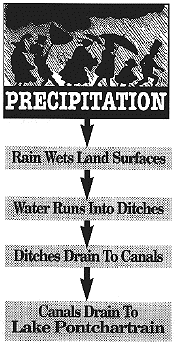
|

- Large piece of visquine plastic
(painters' drop cloth)
- Red, unsweetened Koolaid® or drink mix
- Watering can with small holes in the spout
- Water
- In a large relatively flat area inside or outside the classroom, unfold and spread out the painters' drop cloth.
- Ask the students to pretend that the painters' drop cloth is part of the Lake Pontchartrain Watershed. Ask them to describe what would happen if it suddenly started to rain. (The drop cloth will collect water like the land does in the Lake Pontchartrain Watershed.)
- Ask the students to predict where the water from the rain would go on the drop cloth. (If the drop cloth is relatively flat, the entire surface may collect droplets of water; if there are any elevations and low places the water would be seen at the lowest spot.)
- Ask the students to use objects in the classroom or on the playground to build ridges and low spots in their watershed. Place objects of different shapes and heights under the drop cloth.
- Ask students to choose a spot on the drop cloth which will collect the water. Students may decide to make streams or rivers in their watershed. Have a collecting
apparatus such as a bucket nearby if you are in a classroom or use absorbent
material such as sponges to soak up water.
- Sprinkle Koolaid® all over the watershed area. Designate a student to "rain" on the watershed by gently sprinkling it with the water can. Other students should be designated "observers". These students should observe what happens when it rains in the watershed.
- Ask students to construct a sequence of events chart to describe their observations. An example of a completed sequence of events chart is "Precipitation" (at the top of this page).
Extension:
Ask students to study the shape of the Lake Pontchartrain Watershed. After careful study students could construct a model of the Lake Pontchartrain Basin using the visquine drop cloth.
|
Go back
[an error occurred while processing this directive]
|
